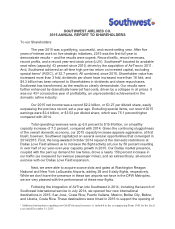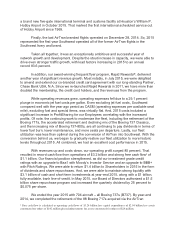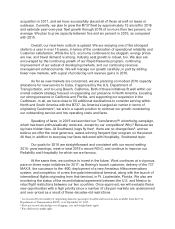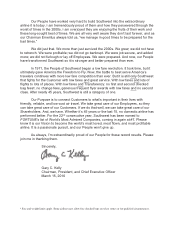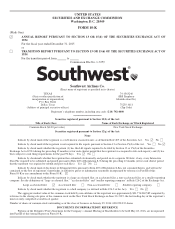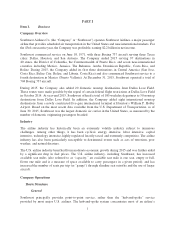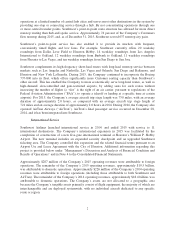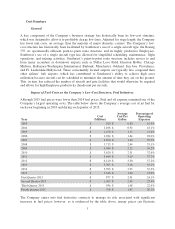Southwest Airlines 2015 Annual Report Download - page 10
Download and view the complete annual report
Please find page 10 of the 2015 Southwest Airlines annual report below. You can navigate through the pages in the report by either clicking on the pages listed below, or by using the keyword search tool below to find specific information within the annual report.operations at a limited number of central hub cities and serves most other destinations in the system by
providing one-stop or connecting service through a hub. By not concentrating operations through one
or more central transfer points, Southwest’s point-to-point route structure has allowed for more direct
nonstop routing than hub-and-spoke service. Approximately 74 percent of the Company’s Customers
flew nonstop during 2015, and, as of December 31, 2015, Southwest served 637 nonstop city pairs.
Southwest’s point-to-point service has also enabled it to provide its markets with frequent,
conveniently timed flights and low fares. For example, Southwest currently offers 20 weekday
roundtrips from Dallas Love Field to Houston Hobby, 14 weekday roundtrips from Los Angeles
International to Oakland, 12 weekday roundtrips from Burbank to Oakland, 11 weekday roundtrips
from Phoenix to Las Vegas, and ten weekday roundtrips from San Diego to San Jose.
Southwest complements its high-frequency short-haul routes with long-haul nonstop service between
markets such as Los Angeles and Nashville, Las Vegas and Orlando, San Diego and Baltimore, and
Houston and New York LaGuardia. During 2015, the Company continued to incorporate the Boeing
737-800 into its fleet, which offers significantly more Customer seating capacity than Southwest’s
other aircraft. This has enabled the Company to more economically serve long-haul routes, as well as
high-demand, slot-controlled and gate-restricted airports, by adding seats for such routes without
increasing the number of flights (a “slot” is the right of an air carrier, pursuant to regulations of the
Federal Aviation Administration (“FAA”), to operate a takeoff or landing at a specific time at certain
airports). For 2015, the Company’s average aircraft trip stage length was 750 miles, with an average
duration of approximately 2.0 hours, as compared with an average aircraft trip stage length of
721 miles and an average duration of approximately 2.0 hours in 2014. During 2014, the Company also
operated AirTran Airways (“AirTran”). AirTran’s final passenger service occurred on December 28,
2014, and it has been integrated into Southwest.
International Service
Southwest Airlines launched international service in 2014, and ended 2015 with service to 11
international destinations. The Company’s international expansion in 2015 was facilitated by the
completion of construction of a new five-gate international terminal at Houston’s William P. Hobby
Airport. The new terminal includes an expanded security checkpoint and an upgraded Southwest
ticketing area. The Company controlled this expansion and the related financial terms pursuant to an
Airport Use and Lease Agreement with the City of Houston. Additional information regarding this
project is provided below under “Management’s Discussion and Analysis of Financial Condition and
Results of Operations” and in Note 4 to the Consolidated Financial Statements.
Approximately $287 million of the Company’s 2015 operating revenues were attributable to foreign
operations. The remainder of the Company’s 2015 operating revenues, approximately $19.5 billion,
was attributable to domestic operations. Approximately $226 million of the Company’s 2014 operating
revenues were attributable to foreign operations (including those attributable to both Southwest and
AirTran). The remainder of the Company’s 2014 operating revenues, approximately $18.4 billion, was
attributable to domestic operations. The Company’s assets are not allocated to a geographic area
because the Company’s tangible assets primarily consist of flight equipment, the majority of which are
interchangeable and are deployed systemwide, with no individual aircraft dedicated to any specific
route or region.
2

